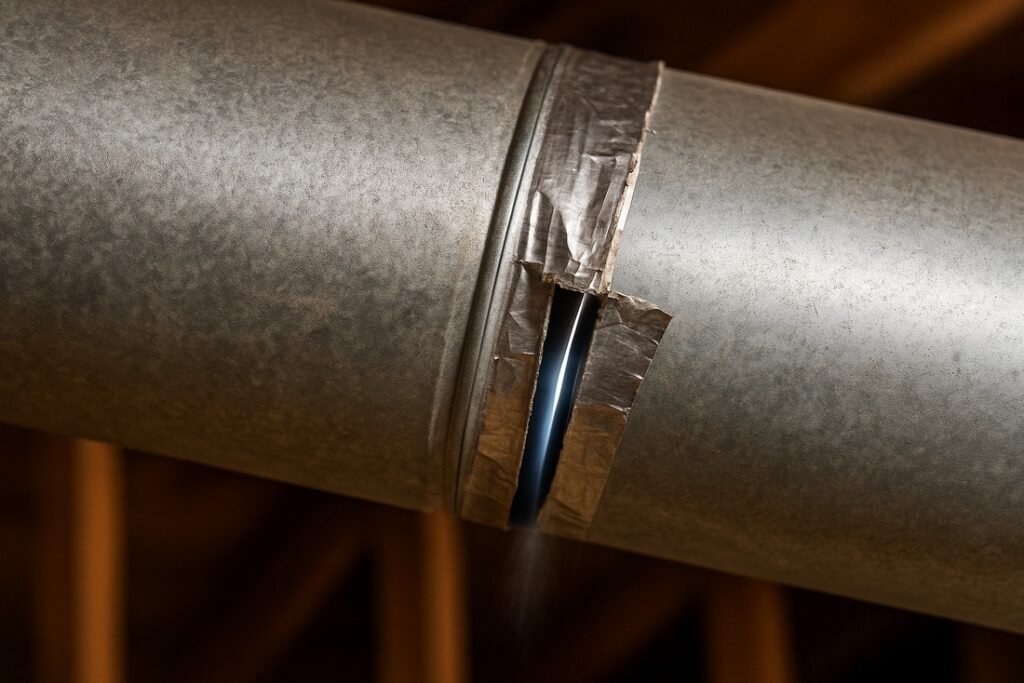Blog
AC duct leak symptoms: hot rooms, dust, and high bills

If some rooms never cool, dust keeps coming back, and power bills rise every summer, you are likely seeing AC duct leak symptoms. Leaky ductwork lets hot, humid air enter the system while cooled air escapes into the attic or garage. Comfort suffers, runtimes increase, and costs climb. Use this guide to spot the signs, try safe checks, and understand how a proper repair gets your home back on track.
What duct leaks do to comfort and costs
Your duct system is a loop. Supplies push conditioned air to rooms. Returns pull air back to the air handler. Gaps in that loop waste cold air and drag in unconditioned air from attics, garages, and wall cavities. The result is uneven temperatures, sticky rooms, and a system that works harder than it should. Odors at startup can join the mix because leaks feed dust and moisture that collect on the coil.
Common AC duct leak symptoms in living spaces
Hot rooms and weak airflow at distant vents – Air that should reach a far bedroom bleeds through loose connections before it ever gets there. You feel strong airflow near the air handler, then a thin stream at the end of the run. The system may run for long stretches without closing the gap, which is a classic comfort complaint tied to duct losses.
Doors that move when the AC starts – If a bedroom door swings or pulls against the frame during a cycle, the room lacks a good return path. Pressure builds, airflow drops, and comfort falls. A simple jump return or transfer grille often restores balance without changing equipment.
High indoor humidity with AC running – Return leaks pull wet attic air into the system. The coil cools that air but cannot remove enough water during short cycles, so the home feels clammy. Fixing the return path and restoring steady cycles brings humidity back in line.
AC duct leak symptoms are tied to dust and air quality
Dust that settles right after cleaning – Leaky returns suck dusty air through framing gaps. That dust coats the blower and coil, then redistributes to rooms. If you see gray streaks or ghosting near supply registers, leaks are likely. Cleaning helps, but sealing has to come first, or dust returns quickly.
Stale or damp odors at startup – Air pulled across damp insulation adds odor to the airstream. Moisture then lingers around the coil, which can start odor and growth. Once the return path is sealed and the drain is flowing, the issue usually fades.
Quick checks you can do safely
Walk room to room while the system runs and compare airflow by hand at each supply. Note which vents feel weak. Close a bedroom door during a cycle and try to reopen it. If it resists, the return path is undersized or blocked. Inspect the filter slot at the air handler. If the cover is missing or loose, that is a direct return leak that pulls unfiltered attic air into the unit. Do not remove access panels and do not spend long in a hot attic. The goal is to gather clues without risk.
Where leaks usually hide
Return plenum seams – Small gaps where the return box meets the cabinet pull a surprising amount of attic air. A bead of mastic and proper foil tape fix this quickly.
Flexible duct at collars – Flex can slip off a metal collar when straps loosen or tape dries out. You often see this where a main trunk splits to branches.
Supply boots and register frames – Leaks around the boot let cooled air dump into wall cavities instead of the room. Proper sealant and a tight boot strap stop the loss.
Filter rack bypass – A filter that does not fit lets air bypass the media. That reduces filtration and sends dust to the coil. A sealed rack and the correct filter size fix both issues.
How a technician confirms AC duct leak symptoms
A technician starts with visual checks and pressure readings. They may use a light smoke puff to show air movement at seams or perform a quick leakage test to quantify the problem. Expect an inspection of the return plenum, filter rack, nearby flex connections, and the supply boots that feed weak rooms. If they find crushed flex or sharp bends, they will recommend rerouting those sections so air can reach the registers. Many leaks are visible once a pro knows where to look, and sealing the biggest openings first brings immediate gains.
Contact FL-Air Heating & Cooling
If you are dealing with AC duct leak symptoms, our team can find the leaks, seal them with the right materials, and balance airflow so rooms feel even again. We serve Tampa Bay with clear pricing and real arrival windows. For fast help, call 813-800-2665 and we will get you on the schedule.








